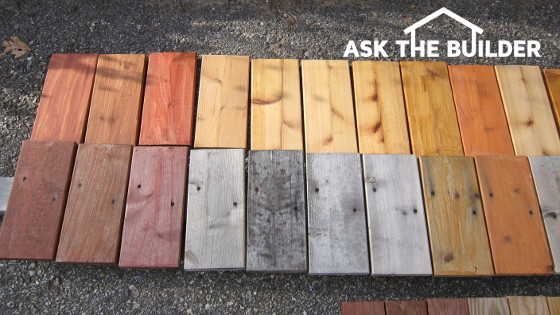Failed Deck Sealer

Here are the side-by-side before and after wood samples. The faded pieces of wood were out in the weather for only six months. CLICK THE PHOTO ABOVE to see all of the Before and After Photos of the deck sealers. Copyright 2017 Tim Carter
Failed Deck Sealer TIPS
- Deck sealers and stains fail in just a few years
- Sun's UV light blasts apart the resins or glue in the sealer
- Darker stains tend to last longer, but it's not a guarantee
- Link below to my own TEST RESULTS
- CLICK HERE to Get Tim's FREE & FUNNY Newsletter!
DEAR TIM: I put my wood deck to bed for the season about a month ago. Suffice it to say I was really upset.
Back in the spring, I went to great lengths to clean the deck and reseal it. I purchased an expensive semi-transparent sealer that did have a small amount of pigment in it.
However, after several months the wood started to gray and then the mildew set in. Now I have to start over when spring arrives. This time I want to do it right.
What advice can you offer when purchasing wood deck sealers? Brandy S., Albany, GA
DEAR BRANDY: This is no consolation, but you're in a large group of consumers that are deeply disappointed with the performance of certain deck sealers.
My Own Failed Sealers
I've been interested in this topic for years, both as a contractor and a homeowner. I've also been on the short end of the stick several times as sealers have failed on my own wood deck surfaces.
Wide Variety Creates Confusion
Wood deck sealers come in all flavors. There are water-based sealants as well as a few oil-based products. Some are heavily pigmented while others have just a hint of pigment. Many homeowners love the look of the lightly pigmented products as they tend to really show off the wood's natural color.
Free & Fast Bids
Sun Destroys Sealers
The trouble is these nearly clear sealers and water repellents are ill-equipped, for the most part, to deal with the harsh ultraviolet (UV) rays of the sun. Five percent of the sun's UV rays contain active photons.
These high-energy particles are like miniature cruise missiles. Whatever they hit, they destroy. They're so powerful they can break the atomic bonds of certain metals like copper and zinc. You can imagine that a deck sealer resin is no match for these powerful photons.
Sun & Skin Analogy
The best analogy I can offer up is what happens to me every spring.
Without fail, I go outdoors on the first balmy spring day and shed my shirt that's been on all winter. I really enjoy the warmth of the infrared rays of the sun on my pasty white skin that's been hidden all winter from any sunlight.
While I'm basking like a seal on a rock, the invisible UV rays are causing sunburn.
You can prevent sunburn by using a sunscreen lotion. The pigments and other nano particles in wood sealers act to block damaging UV rays. They can't stop it, but some sealers can slow down the damage.
More Pigment Is Better
However, lightly pigmented wood sealers simply don't have enough pigment to block the UV rays of the sun that turn wood gray in color. Heavily pigmented sealers and water repellents that are deep in color are akin to applying a sunscreen to your deck that might have a SPF value of 100 or higher!
My Own Huge Test
This past year I decided to do an extensive side-by-side test of about sixteen different wood sealers. Some were heavily pigmented and others were nearly clear. I carefully followed the instructions with regards to cleaning the wood and applying the products.
Furthermore, I created two sets of wood samples. Each set contained treated lumber wood and cedar. Both sets were sealed at the same time inside a garage out of the sun. The samples were allowed to dry.
Control Pieces In The Dark
One set never left the garage. Once dry, I boxed up one set and set them aside so they could be the control samples. The other set was attached to pieces of wood to simulate how they would be applied to a real deck.
Test On The Dock
These samples were then taken down to my boat dock where they are punished by the sun from sunrise until mid-afternoon. I can't think of a better way to test deck sealers than a dock setting where the wood has no place to hide from the sun.
Dock Stain Videos
I taped the following two videos two years BEFORE I did the extensive deck sealer test. I just wanted to show you how wide-open it is down at the dock.
Some Failed Within A Month!
The shocking thing, and you'll not be surprised based on your experience, is that I started to see failure in some of the finishes within a month. What's more, the sealers and water repellents on the cedar performed worse than those same sealers applied to pieces of treated lumber.
Severe Mold & Mildew
Some of the cedar samples developed severe mold and mildew even though they were inches away from the treated lumber samples. I suspect the copper used to make the treated lumber rot resistant was leaching through the sealers. Copper is a natural biocide.
Medium & Dark Pigments Performance
The sealers that have medium to dark pigment are doing the best so far. My test has only been going on for seven months, so I'll have more data as we approach summer. But suffice it to say that the lightly pigmented products on cedar have already failed my test.
Column 965
2 Responses to Failed Deck Sealer